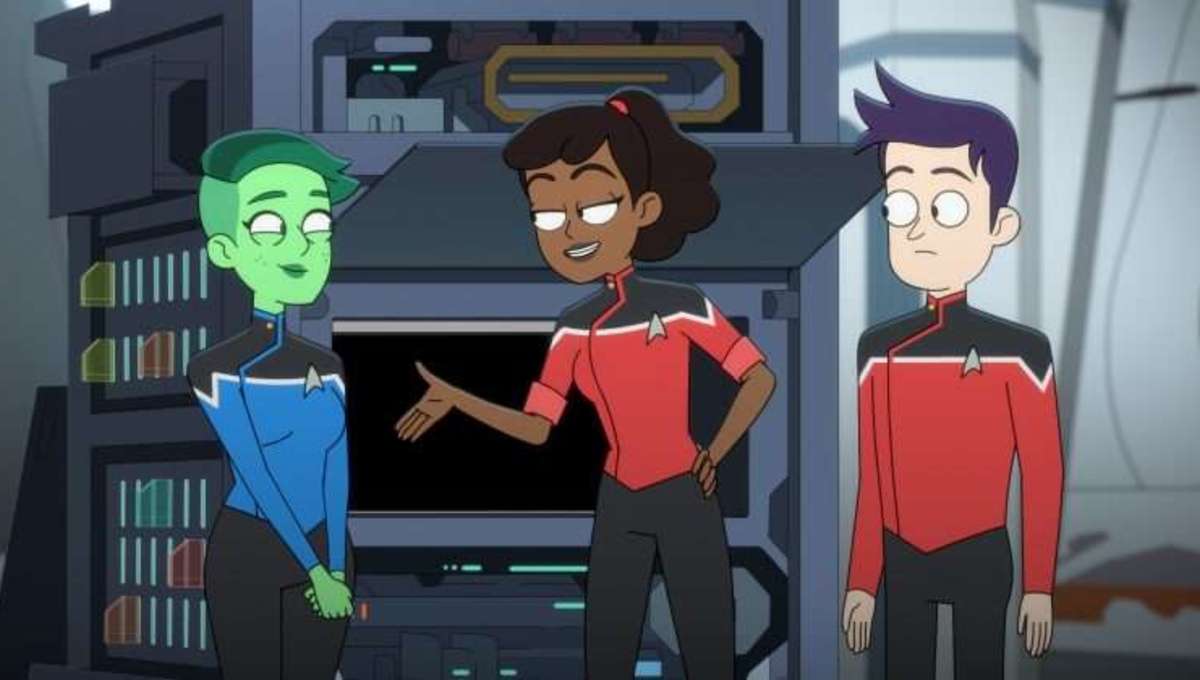
The third currently-running incarnation of the long-running, and wildly influential, Star Trek series is one of its least likely: a half-hour animated comedy.
The brainchild of Mike McMahan — alumni of Second City, and former writer and/or co-creator for Rick And Morty, Solar Opposites, and with experience working on both Drawn Together and South Park — the series is a thematically different approach to a very familiar universe. Set aboard the USS Cerritos, the series follows the grunts of the ship who are responsible for day-to-day operations, leaving the more exciting, glamorous adventures to the bridge crew.
The pilot episode introduces us to the quartet of main characters — Beckett Mariner (Tawny Newsome), Brad Boimler (Jack Quaid), D’Vana Tendi (Noël Wells), and Sam Rutherford (Eugene Cordero) — all ensigns working in the titular lower decks at the aft of the ship. Their mission is to establish Second Contact with the planet Galar, a process which includes bureaucratic processes and parliamentary procedures; basically, the nitty-gritty of establishing a functioning society with the Federation.
Mariner, hyperactive and smarter than she at first lets on, has been acting beyond her mandate and responsibilities, something that rankles captain Carol Freeman (Dawnn Lewis) to the point of assigning the career-minded Boimler to keep tabs on her. Freeman, we later learn, is Mariner’s mother, and has been looking for any excuse to get her daughter reassigned.
In the middle of Boimler and Mariner’s misadventures — they’re trapped for half the episode by a giant, yet herbivorous, alien farm animal on Galar — the Cerritos crew is inadvertently infected by a Galarian virus that turns its victims into mindless, flesh-eating rage zombies, a cure for which the short-tempered Caitian Doctor T’Ana (Gillian Vigman) has to render with Tendi’s assistance.
All of these elements occur within the show’s 23 minutes, and it flies by at a breakneck speed. The strength of the show lies in its economy of time: with such a confined timeslot, the energy is cranked to 11. The effect is similar to JJ Abrams’ rebooted first movie, but less jarring since these are characters we’ve never seen before, in a medium where hyper-active movement is the norm. It would make sense for Tendi and Rutherford to backflip over and jump-kick infected crewmembers since the animation warrants such fluid action (seeing Spock, for instance, attempt the same sort of action in Star Trek Into Darkness had the opposite effect; that was a man who had no need to do anything more complicated than a neck pinch).
The use of animation also allows something to return to Star Trek that has been missing for some time: light! Color! The show is vibrant and buoyant and returns a feeling of optimism to the universe that had only just begrudgingly been reinserted in later episodes of Discovery and Picard. Setting the series after the events of Nemesis (but before the events of Star Trek Picard) is also refreshing: no longer is this universe coupled to the past (as in Discovery, and the rebooted movies), nor anchor itself to familiar characters that were already well established.
Star Trek hasn’t been animated since 1974, and where that iteration was basically the original series in cartoon form (with all the headiness and pacing intact), Lower Decks is wise in revving up the pacing and embracing the conceits of the genre.
https://www.youtube.com/watch?v=_HzRGqvRK8U
The references to events from other series, and characters, grounds the series to what we already know, but even referencing things like the Monkees, or seeing the characters getting drunk makes them more real (to say nothing of hearing them swearing. Star Trek Discovery likewise introduced all these additions to…mixed results. It seems to land better in animation).
Right now, I’m onboard for this series. It’s smart, funny, buoyant and, more than anything else, fun as hell. 5/5 Bottles of Romulan Whiskey.
-J.L. Caraballo



